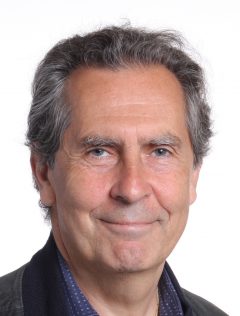Dr. Rafael Radi, M.D.

Departamento de Bioquímica, Facultad de Medicina
Universidad de la República, General Flores 2125
Montevideo, 11800, PA Uruguay
Email: rradi@ fmed.edu.uy
Phone: 598 2 924 9561
Fax: 598 2 924 9563
Nitroxidative Stress: Molecular Mechanisms and Biological Consequences
Excess production of nitric oxide (NO) in the presence of reactive oxygen species and/or transition metal-containing centers lead to the formation of NO-derived oxidants. For instance, the diffusion-controlled reaction of NO with superoxide radical (O2−) yields peroxynitrite anion (ONOO−), while the reactions of hydrogen peroxide (H2O2) and nitrite (NO2−) with hemeperoxidases lead to the formation of nitrogen dioxide (NO2). Nitric oxide-derived oxidants promote oxidation, nitration and nitrosation of biomolecules, chemical modifications that can result in changes of their structure and function and cause alteration of cell homeostasis via “nitroxidative stress”. In the presentation, I will 1) analyze our current understanding of the molecular mechanisms that lead to nitroxidative stress, with a focus in protein modifications, and 2) provide evidence for a causative link of excess NO-derived oxidants levels with biological responses related to physiology and pathophysiology. A comprehensive understanding of the biochemical basis of nitroxidative stress is facilitating the development of pharmacological- and genetic engineering-based interventions of prospective therapeutic value.
Rafael Radi, MD, PhD was born in Montevideo, Uruguay. He studied Medicine and Biochemistry at Universidad de la República, Uruguay, obtaining the degrees in 1989 and 1991, respectively. As a postdoctoral fellow at the University of Alabama at Birminghan (USA) in the early nineties in Bruce A. Freeman’s lab, he played a key role on the discovery of peroxynitrite and the biochemical characterization of oxidizing and nitrating species derived from nitric oxide in biological systems. Upon returning to Uruguay, he advanced through all the academic ranks to the currently position as Professor and Chairman of Biochemistry and Director of the Center for Free Radical and Biomedical Research, Facultad de Medicina, Universidad de la República, Uruguay. Some of his honours include the Leloir Award to International Cooperation (2012), Discovery Award of the Society for Free Radical Biology and Medicine (SFRBM, 2011), Alexander Von Humboldt Senior Award (2010) and the National Prize in Science and Technology (2007), among many others. He was a Howard Hughes International Research Scholar (2000-2011). He is the President-Elect of the Society for Free Radical Research International and Past-President of the Society for Free Radical Biology and Medicine. Founding Member and Secretary of Academia de Ciencias del Uruguay and foreign member of the Academy of Sciences of Argentina, Brazil, The Developing World and Latin America. He is Adjunct Professor at the University of Buenos Aires, Pittsburgh, Alabama at Birmingham, and Vanderbilt University. He is currently Associate Editor of Free Radical Research and Free Radical Biology and Medicine. He has played an important role in the development of research infrastructure and science policy at the national and international levels. His current research interests include the biological chemistry and pharmacology of peroxynitrite and nitrating species, structural biology of oxidized proteins, redox control of microbial invasion to mammalian cells, role of mitochondrial dysfunction in disease progression and development and testing of redox-sensitive probes and redox-based therapeutics.
Dr. Siegfried Hekimi, Ph.D.

Department of Biology, McGill University
1205 Avenue Docteur Penfield (Stewart Building)
Montréal, Québec, H3A 1B1, Canada
Email: siegfried.hekimi@mcgill.ca
Phone: (514) 398-6440
Fax: (514) 398-5069
Pro-Longevity Mitochondrial ROS Signaling
The oxidative stress theory of aging postulates that aging results from the accumulation of molecular damage caused by mitochondrial reactive oxygen species (ROS) generated during normal metabolism. In the nematode C. elegans several mutations in mitochondrial proteins lead to a substantial increase in longevity. Example include isp-1 and nuo-6, which encode subunits of mitochondrial respiratory chain complexes, and sod-2, which encodes the main mitochondrial superoxide dismutase. We have investigated the involvement of ROS metabolism in the mechanisms of longevity of these mutants. Our findings indicate that the longevity of these mutants is not the result of lower accumulation of oxidative damage. Rather we find that their mitochondria display an enhanced generation of superoxide, a property that we find to be necessary and sufficient for their increased longevity. We propose a general model that suggests that the level of ROS generation increases with aging because the signalling function of ROS is protective and is stimulated by age-dependent damage and cellular dysfunction. We have investigated the signal transduction mechanisms by which mitochondrial ROS (mtROS) induce longevity. We find the mtROS signal is relayed by the conserved, mitochondria-associated, intrinsic apoptosis signalling pathway, in a manner completely independent of apoptosis per se. In vertebrates, mtROS stimulate apoptosis through the intrinsic pathway to protect from severely damaged cells. Our observations in nematodes demonstrate that sensing of mtROS by the apoptotic pathway can, independently of apoptosis, elicit protective mechanisms that keep the organism alive under stressful conditions. This results in extended longevity when mtROS generation is inappropriately elevated, as in the mitochondrial mutants we have been studying. We believe our findings help to clarify the relationships between mitochondria, ROS, apoptosis, and aging.
From : http://hekimilab.mcgill.ca/hekimi.php
Siegfried Hekimi was born in Zürich and obtained his undergraduate degree in Biology at the University of Geneva in 1980. He did not immediately pursue graduate studies but instead engaged in a full-time career as a cyclist, first as a member of the amateur Swiss National Team and then as a professional in various teams in Switzerland and Italy. He was selected for the World Championships four times and participated in such well known races as the Tour de France and the Giro d’Italia. After this adventure he renewed with his true calling by completing a PhD in Neurobiology in 1988 with Professor Michael O’Shea, again at the University of Geneva. His thesis focussed on the biosynthesis of neuropeptides, which was poorly understood at the time.
It was to tackle this problem that he first developed an interest in using invertebrate models to study evolutionarily conserved processes. This approach led him to study the cardiac bodies of locusts, a pair of endocrine glands almost completely dedicated to the production of the peptidic adipokinetic hormones. He then moved to the famed Laboratory of Molecular Biology (LMB) of the Medical Research Council in Cambridge, UK, to collaborate with Dr J.J. White as a post-doctoral fellow of the Swiss National Science Fund. It is at the LMB that Sydney Brenner developed the nematode Caenorhabditis elegans as one of the premier research tools in genetics, and where Hekimi developed his interest for using ‘the worm’ for translational studies in the biology of aging. It is also in Cambridge that he identified the first mutants that helped to demonstrate that aging could be manipulated genetically and that inducing mild mitochondrial dysfunction could in fact slow down the aging process of animals. After three years in Cambridge, Hekimi joined the Department of Biology at McGill University.
He became a Canadian and remained at McGill where he is a full professor since 2004. He has continued his research on the aging process, extending his reach to include mouse models of aging and of age-dependent diseases, as well as drug discovery through the medium of a spin-off company, Chronogen, which closed in 2007 when its assets were acquired by larger entities. His research at McGill University has been principally funded by the Canadian Institute of Health Research and the Canadian Fund for Innovation, and also by the National Science and Engineering Council, by the Canadian Cancer Society Research Institute, industrial partners, and McGill University.
He holds two endowed chairs, the Strathcona Chair of Zoology (since 2004), and the newly created Robert Archibald & Catherine Louise Campbell Chair in Developmental Biology (since 2007). In 2010 he became a Fellow of the Royal Society of Canada and two years later was awarded the Flavelle Medal of the RSC for outstanding contribution to biological science. Hekimi has published more than 80 highly-cited peer-reviewed publications, has several patent applications, has given over 100 invited lectures and conferences presentations, and has supervised 67 graduate students and post-doctoral fellows. He is also a populariser who is regularly interviewed by radio and television broadcasters and the written press to explain the meaning of new findings in the biology of aging, including his own, for human aging and human health.
Dr. Richard Schulz, Ph.D.

Departments of Pediatrics and Pharmacology
University of Alberta
4-62 Heritage Medical Research Centre
Edmonton, Alberta, Canada T6G 2S2
Email: Richard.Schulz@ualberta.ca
Phone: (780) 492-6581
Fax: (780) 492-9753
Why inhibitors of matrix metalloproteinase-2 (MMP-2) are next generation drugs to treat diseases of oxidative stress injury
Matrix metalloproteinases may be best known for their biological actions to proteolyse extracellular matrix proteins to affect tissue remodeling, both physiological and pathological, however it is now understood that they have several intracellular functions. My lab discovered that MMP-2, found in almost every cell type, also localizes to specific subcellular organelles and has unique susceptible protein targets inside the cardiac myocyte. We recently found that a combination of MMP-2 signal sequence quality, as well as its splicing, dictate its distribution between the cytosol and the secretory pathway. MMP-2 is activated directly by oxidative stress (in the form of peroxynitrite) to a S-glutathiolated Cys derivative which is catalytically active and distinct from the secreted form. It is an integral sarcomeric protein localized to thin, thick and intermediate (titin) filaments, most prominently at the Z-line, and is also found in nuclei, mitochondria, the mitochondrial associated membrane, and caveolae. During oxidative stress injury of the heart MMP-2 is rapidly activated and cleaves specific sarcomeric and cytoskeletal targets including troponin I, alpha-actinin, myosin light chain-1, glycogen synthase kinase-3beta and titin. The cleavage of these sarcomeric proteins results in the rapid loss of contractile function. MMP inhibitor drugs prevent the cleavage of these targets and protect the heart from oxidative stress injury by preventing inefficient contractile function. Such drugs, including doxycycline, which possesses MMP inhibitory properties distinct from its antibacterial actions, are promising drugs for the treatment of ischemic heart disease and heart failure. Post-translational modifications of intracellular MMP-2, including S-glutathiolation and its phosphorylation, will allow the development of inhibitors specifically targeting intracellular but not extracellular MMP-2, and should be useful in treating diseases caused by oxidative stress in the body.
From: http://www.ualberta.ca/~rschulz/
The Schulz lab has expertise in cardiovascular pharmacology and pathophysiology, particularly in relation to oxidative stress. Many cardiovascular diseases involve an increase in oxidative stress to the heart and blood vessels, causing damage to these tissues and contributing to acute heart failure.
Our lab investigates the role of some specific molecules in contributing to this oxidative stress damage. Specifically, we are interested in the roles of nitric oxide, superoxide and peroxynitrite in cardiac and vascular injury relating to the activation of the immune system as well as in myocardial ischemia and reperfusion injury.
We have discovered that some of these molecules may mediate their damaging effects through activation of a protein enzyme called matrix metalloproteinase-2 (MMP-2) within the cardiac myocyte. Although MMP-2 was previously thought to act only on extracellular targets, our lab has discovered that MMP-2 also targets (and subsequently damages) intracellular proteins.
Our short-term objective is to understand the contribution of each of these molecules in the development of acute heart failure. Our long-term objective is to develop and test specific pharmacological treatments to protect the heart from oxidative stress injury (e.g. matrix metalloproteinase or nitric oxide synthase inhibitors, superoxide or peroxynitrite scavengers.